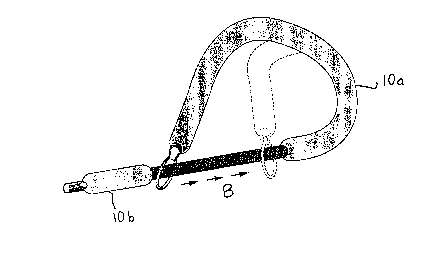Some of the information on this Web page has been provided by external sources. The Government of Canada is not responsible for the accuracy, reliability or currency of the information supplied by external sources. Users wishing to rely upon this information should consult directly with the source of the information. Content provided by external sources is not subject to official languages, privacy and accessibility requirements.
Any discrepancies in the text and image of the Claims and Abstract are due to differing posting times. Text of the Claims and Abstract are posted:
| (12) Patent Application: | (11) CA 2276084 |
|---|---|
| (54) English Title: | MARINE RESCUE SNARE |
| (54) French Title: | NOEUD COULANT POUR SAUVETAGE MARITIME |
| Status: | Deemed Abandoned and Beyond the Period of Reinstatement - Pending Response to Notice of Disregarded Communication |
| (51) International Patent Classification (IPC): |
|
|---|---|
| (72) Inventors : |
|
| (73) Owners : |
|
| (71) Applicants : |
|
| (74) Agent: | SMART & BIGGAR LP |
| (74) Associate agent: | |
| (45) Issued: | |
| (22) Filed Date: | 1999-06-23 |
| (41) Open to Public Inspection: | 1999-12-25 |
| Examination requested: | 2000-04-05 |
| Availability of licence: | N/A |
| Dedicated to the Public: | N/A |
| (25) Language of filing: | English |
| Patent Cooperation Treaty (PCT): | No |
|---|
| (30) Application Priority Data: | ||||||
|---|---|---|---|---|---|---|
|
A floatable marine rescue snare is provided
comprising one or more buoyant elongate rods axially
connected by a tie line and formed in a loop, with
slippage means fixed to one end of the snare and slidably
engaged with a portion of the snare between its two ends.
The tie line connects to a rescue rope by which it may be
thrown to a victim. Once looped around the upper torso
of the victim, the snare can be tightened by pulling on
the rescue rope to secure a rescue link while the buoyant
body of the snare maintains the victim afloat.
Note: Claims are shown in the official language in which they were submitted.
Note: Descriptions are shown in the official language in which they were submitted.

2024-08-01:As part of the Next Generation Patents (NGP) transition, the Canadian Patents Database (CPD) now contains a more detailed Event History, which replicates the Event Log of our new back-office solution.
Please note that "Inactive:" events refers to events no longer in use in our new back-office solution.
For a clearer understanding of the status of the application/patent presented on this page, the site Disclaimer , as well as the definitions for Patent , Event History , Maintenance Fee and Payment History should be consulted.
| Description | Date |
|---|---|
| Inactive: IPC from MCD | 2006-03-12 |
| Application Not Reinstated by Deadline | 2004-10-12 |
| Inactive: Dead - Final fee not paid | 2004-10-12 |
| Deemed Abandoned - Failure to Respond to Maintenance Fee Notice | 2004-06-23 |
| Deemed Abandoned - Conditions for Grant Determined Not Compliant | 2003-10-10 |
| Notice of Allowance is Issued | 2003-04-10 |
| Letter Sent | 2003-04-10 |
| Notice of Allowance is Issued | 2003-04-10 |
| Inactive: Approved for allowance (AFA) | 2003-03-31 |
| Amendment Received - Voluntary Amendment | 2000-05-15 |
| Letter Sent | 2000-04-27 |
| Request for Examination Requirements Determined Compliant | 2000-04-05 |
| All Requirements for Examination Determined Compliant | 2000-04-05 |
| Request for Examination Received | 2000-04-05 |
| Application Published (Open to Public Inspection) | 1999-12-25 |
| Inactive: Cover page published | 1999-12-24 |
| Inactive: First IPC assigned | 1999-08-19 |
| Inactive: Filing certificate - No RFE (English) | 1999-08-05 |
| Filing Requirements Determined Compliant | 1999-08-05 |
| Application Received - Regular National | 1999-08-03 |
| Abandonment Date | Reason | Reinstatement Date |
|---|---|---|
| 2004-06-23 | ||
| 2003-10-10 |
The last payment was received on 2003-05-22
Note : If the full payment has not been received on or before the date indicated, a further fee may be required which may be one of the following
Please refer to the CIPO Patent Fees web page to see all current fee amounts.
| Fee Type | Anniversary Year | Due Date | Paid Date |
|---|---|---|---|
| Application fee - small | 1999-06-23 | ||
| Request for examination - small | 2000-04-05 | ||
| MF (application, 2nd anniv.) - small | 02 | 2001-06-26 | 2001-06-26 |
| MF (application, 3rd anniv.) - small | 03 | 2002-06-24 | 2002-05-15 |
| MF (application, 4th anniv.) - small | 04 | 2003-06-23 | 2003-05-22 |
Note: Records showing the ownership history in alphabetical order.
| Current Owners on Record |
|---|
| K. CRAIGE KELLETT |
| Past Owners on Record |
|---|
| None |